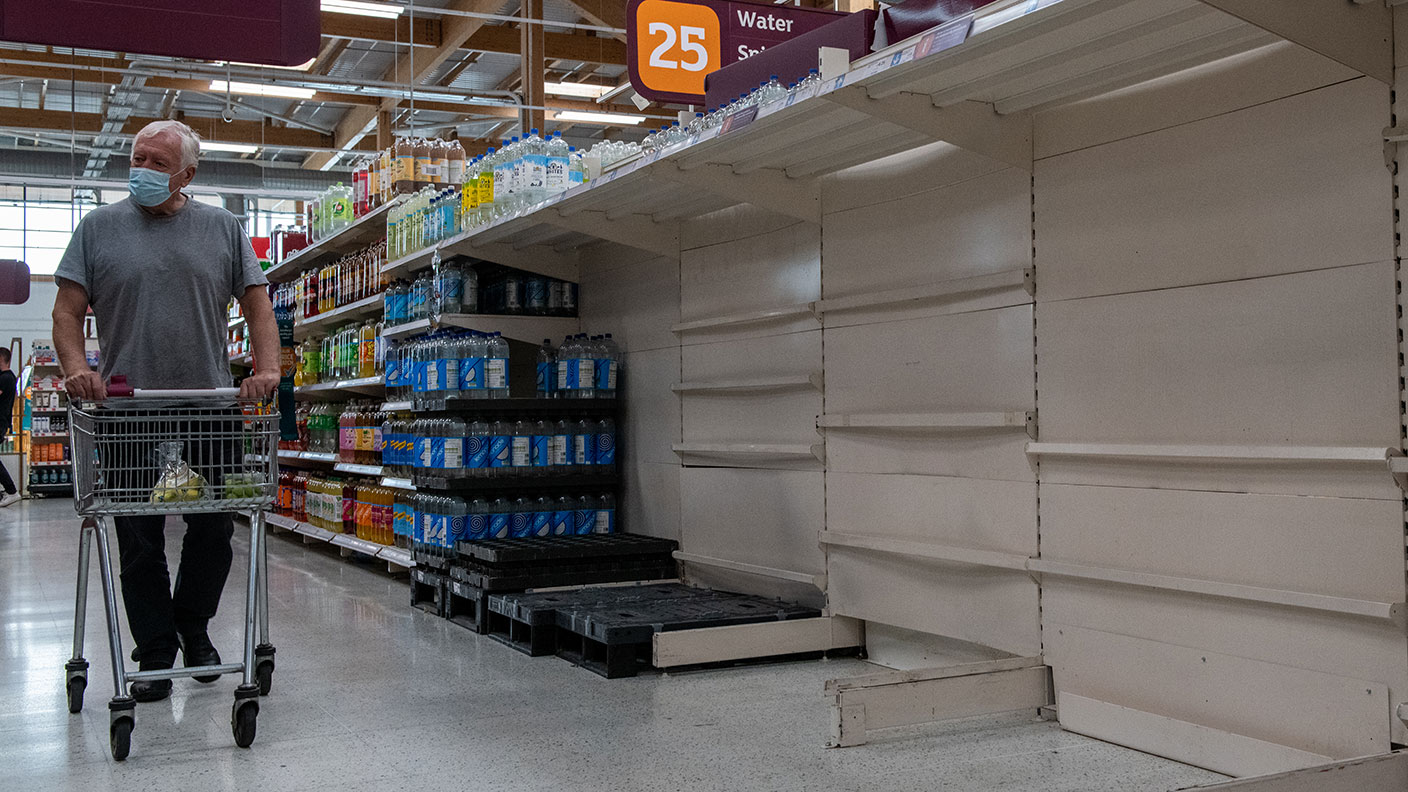Why is the UK short of CO2 and what does it mean for you?
The UK is experiencing a carbon dioxide shortage that could lead to empty shelves in supermarkets. Saloni Sardana explains what’s going on and how it affects you.


The UK’s output of carbon dioxide (CO2) has fallen in half. And confusing as it might seem, that’s a bad thing.
CO2 is most commonly associated with greenhouse gas emissions, which we’re meant to be cutting down on. However, CO2 is also a critical industrial gas. It’s used in everything from packaging to keep meat fresh, to stunning pigs and chickens for slaughter; producing fizzy drinks to dispensing beer; promoting plant growth; and making fire extinguishers.
So a shortage raises the spectre of not just higher prices, but shortages of certain foodstuffs and products.
MoneyWeek
Subscribe to MoneyWeek today and get your first six magazine issues absolutely FREE

Sign up to Money Morning
Don't miss the latest investment and personal finances news, market analysis, plus money-saving tips with our free twice-daily newsletter
Don't miss the latest investment and personal finances news, market analysis, plus money-saving tips with our free twice-daily newsletter
So why are we low on CO2 and what might it mean for your money?
What is CO2 and why is it so important?
The CO2 shortage comes at a very bad time. The Covid-19 pandemic and, to an extent, Brexit had already exposed the fragility of our supply chains, with the most obvious symptom being a worldwide shortage of HGV drivers. These factors were already driving up inflation and threatening to leave shelves empty.
So what’s causing it? Much of the CO2 shortage is a direct result of the spike in natural gas prices (which has driven UK energy prices to record highs). You can read about that here.
To cut a long story short, the high price of natural gas has resulted in fertiliser producer CF Industries shutting down two plants in Teesside and Cheshire, simply because they’re not economical to run. Combined, these two plants account for 40% of the UK’s fertiliser production.
That’s bad enough in itself – but they also produce CO2 as a by-product. So not only were they responsible for a big chunk of our fertiliser supply, but also 60% of domestic food-grade CO2 production.
This is all being exacerbated by the fact that the UK cannot rely on replacement imports from Europe, because plants on the continent are being hit by the same problems. For example, a Dutch plant that normally supplies the UK with CO2 is prioritising its European Union clients, reports Bloomberg.
How badly does the CO2 shortage threaten food supplies?
This isn’t the first time we’ve faced a CO2 shortage. In 2018, the UK experienced an acute shortage when operators shut down production plants for maintenance and an unusually long heatwave kept demand for drinks and frozen products high.
This time, however, the situation is looking worse as both the fertiliser plants were closed indefinitely rather than just for maintenance work, although it now looks as though the government has come to a deal to get the plants running again (more on that in a moment).
In any case, the British Soft Drinks Association has warned it is only a matter of days before the CO2 stockpiles required to produce beverages run out. AG Barr, the maker of Scotland’s flagship carbonated drink, Irn-Bru, warned on Monday that the CO2 shortage may hit production.
Meanwhile, retailers have been expressing alarm on what the shortage might mean for the next few weeks, let alone the run-up to Christmas. “This is no longer about whether or not Christmas will be OK – it's about keeping the wheels turning and the lights on so we can actually get to Christmas. This could become a problem over the coming days and weeks, so this is not an issue that's months away”, said Richard Walker, Iceland’s managing director.
Pig farmers have warned that they may only be a few weeks away from having to partake in the first mass killing of livestock on farms in 20 years if the shortage persists, reports ITV.
How can CO2 production be increased?
As Lilah Howson Smith, a senior analyst at political risk consultancy Global Counsel, points out to the BBC, raising the CO2 supply is tricky because "it's dependent on the supply and demand for fertiliser, not demand for the CO2 itself. That means there is a real fractured sense of responsibility when it comes to solving the problem.”
In short, the easiest way to deal with the problem is to get the fertiliser factories back online. The good news is that the government has struck a deal to do just that. As the BBC reports: “it is not yet clear what incentives” the company has been offered, and it could also take up to three days to get the plants producing CO2 again.
What is the effect on consumers and investors?
Consumers were already facing higher prices and food price inflation. Hopefully the resumption of fertiliser production might at least prevent the worst of that.
For investors, the effect is a little more complicated because of the number of different variables involved. But boiling it down, the CO2 crisis is ultimately a symptom of soaring energy prices. And as my colleague John pointed out this morning, investors looking to play the energy crisis might be best to tap into the oil and gas market, either directly or via funds to make money from soaring energy prices.
Soaring energy prices and a shortage of CO2 shows that for all that talk of phasing out fossil fuels and becoming more environmentally friendly, we still need help to transition from the old world to our new clean future, regardless of how ambitious the targets set by politicians appear. So it is likely that demand for oil won’t go away any time soon – it’s worth investing accordingly.
Get the latest financial news, insights and expert analysis from our award-winning MoneyWeek team, to help you understand what really matters when it comes to your finances.
Saloni is a web writer for MoneyWeek focusing on personal finance and global financial markets. Her work has appeared in FTAdviser (part of the Financial Times), Business Insider and City A.M, among other publications. She holds a masters in international journalism from City, University of London.
Follow her on Twitter at @sardana_saloni
-
 ‘Why I have ditched my Help to Buy ISA for cash savings and the stock market’
‘Why I have ditched my Help to Buy ISA for cash savings and the stock market’Without the 25% bonus, my Help to Buy ISA is effectively redundant, says MoneyWeek writer Sam Walker.
-
 Is your inheritance tax allowance cut if you sell to downsize or sell your home to pay for care?
Is your inheritance tax allowance cut if you sell to downsize or sell your home to pay for care?Downsizing relief is a little-known benefit that could save your loved ones tens of thousands of pounds in inheritance tax after you’ve died.
-
 UK wages grow at a record pace
UK wages grow at a record paceThe latest UK wages data will add pressure on the BoE to push interest rates even higher.
-
 Trapped in a time of zombie government
Trapped in a time of zombie governmentIt’s not just companies that are eking out an existence, says Max King. The state is in the twilight zone too.
-
 America is in deep denial over debt
America is in deep denial over debtThe downgrade in America’s credit rating was much criticised by the US government, says Alex Rankine. But was it a long time coming?
-
 UK economy avoids stagnation with surprise growth
UK economy avoids stagnation with surprise growthGross domestic product increased by 0.2% in the second quarter and by 0.5% in June
-
 Bank of England raises interest rates to 5.25%
Bank of England raises interest rates to 5.25%The Bank has hiked rates from 5% to 5.25%, marking the 14th increase in a row. We explain what it means for savers and homeowners - and whether more rate rises are on the horizon
-
 UK inflation remains at 8.7% ‒ what it means for your money
UK inflation remains at 8.7% ‒ what it means for your moneyInflation was unmoved at 8.7% in the 12 months to May. What does this ‘sticky’ rate of inflation mean for your money?
-
 Would a food price cap actually work?
Would a food price cap actually work?Analysis The government is discussing plans to cap the prices of essentials. But could this intervention do more harm than good?
-
 Is my pay keeping up with inflation?
Is my pay keeping up with inflation?Analysis High inflation means take home pay is being eroded in real terms. An online calculator reveals the pay rise you need to match the rising cost of living - and how much worse off you are without it.
